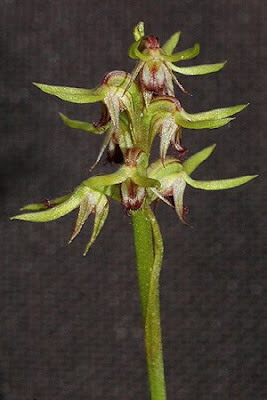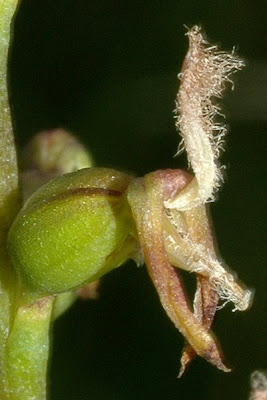The best example of this is the group of plants known as Midge Orchids: "Corunastylis" (formerly classed as Genoplesium). These tiny flowers are very difficult to identify, and the published texts have photographs which are frequently inadequate (mostly because of the small flower size) and the fact that the distinguishing characteristics are frequently microscopic. The PlantNET website offers botanical drawings, which are drawn by botanists who have dissected the flower, and have examined it with a laboratory microscope. I do not have those facilities.
The digital camera is the best asset for the likes of myself. However, you still need to have taken about 10 photos from all the right angles, to get the full details of the plant, including the leaves. And that assumes that your photos are perfect (they seldom are, when taken out in the field).
Exhibit A: - a dark Corunastylis, with hairy labellum and fringed dorsal sepal. In consultation with fellow Orchid enthusiast Colin Rowan, I concluded the best "fit" I could find was Corunastylis morrisii. His response was: "If I found them in Victoria I would certainly call them C. morrisii". One of Colin's photos of this species in Victoria may be found by using this link.
As you will realise if you visit Colin and Mischa's Retired Aussies website, these people are greatly experienced Orchadians, and I value their advice greatly. According to PlantNET, this species is only known in NSW from Braidwood and Nerriga area. My plant was found at Tourist Road, Kangaloon - 150 Km out of the known range for that species. See my difficulty?
Corunastylis morrisii
 Exhibit B: Corunastylis species, probably C. oligantha. This species is newly classified, and the name does not appear on PlantNET, and a Google image search draws a blank. That makes it hard. The only reference I have, so far, is David Jones's book. Tony Bishop's book had good photos of this plant, but the species had not been named when his book was published. Good as the Jones book is, the photos are not really enough for me to make an absolute identification. I hope to print these images, and show them to some Orchid experts shortly.
Exhibit B: Corunastylis species, probably C. oligantha. This species is newly classified, and the name does not appear on PlantNET, and a Google image search draws a blank. That makes it hard. The only reference I have, so far, is David Jones's book. Tony Bishop's book had good photos of this plant, but the species had not been named when his book was published. Good as the Jones book is, the photos are not really enough for me to make an absolute identification. I hope to print these images, and show them to some Orchid experts shortly.Corunastylis oligantha (probably) 

C. oligantha is recorded as occurring in the Braidwood/Mongarlowe area, 200 Km south from here. Again, I am faced with the same difficulty as with the previous species - it looks right. It fits the descriptions, except for the location. I found this species at Medway village, and Tourist Road, Kangaloon. Below is a closer photo of the same species, with the flower tilted back slightly, to reveal the dorsal sepal (at the bottom of the flower). The lateral sepals (above the flower) are very obviously rounded in their shape - in contrast to the next species, below.
Corunastylis oligantha (probably)
 Here is a comparison photo of the dorsal sepal of the two species mentioned above. The Medway plant C. oligantha (?) is on the right. Clearly the dorsal sepal does not have fringed edges. Whereas the other plant does. The reason I stress this is that I was told, originally, that based upon the locality, the flowers I had found were likely to be C. fimbriata. Clearly the plant on the right is not "fringed " on the dorsal sepal (which is a definite feature for that species). So, that rules out C. fimbriata. The next best "fit" is C. oligantha, but it is not recorded from anywhere near here. See my problem?
Here is a comparison photo of the dorsal sepal of the two species mentioned above. The Medway plant C. oligantha (?) is on the right. Clearly the dorsal sepal does not have fringed edges. Whereas the other plant does. The reason I stress this is that I was told, originally, that based upon the locality, the flowers I had found were likely to be C. fimbriata. Clearly the plant on the right is not "fringed " on the dorsal sepal (which is a definite feature for that species). So, that rules out C. fimbriata. The next best "fit" is C. oligantha, but it is not recorded from anywhere near here. See my problem?Comparison of dorsal sepals of two species.
Corunastylis morrisii (left) and Corunastylis oligantha (right)
Corunastylis morrisii (left) and Corunastylis oligantha (right)
 I subsequently went with Alan Stephenson, to Tallong, in search of C. plumosa, a geographically restricted (endemic) species. We did not find that species, but we did find this next plant (below).
I subsequently went with Alan Stephenson, to Tallong, in search of C. plumosa, a geographically restricted (endemic) species. We did not find that species, but we did find this next plant (below).Exhibit C: This plant differs from C. oligantha in the shaping (angle) of the lateral sepals. These ones look like a goat's horns, held out prominently either side of the top of the flower. The labellum (pointing straight forward , towards the lens, and slightly out of focus in this image) is extremely hairy (fringed) as is the dorsal sepal. The dorsal sepal lacks the purple stripes of C. oligantha (?) above. I conclude that this plant is likely to be the true species C. fimbriata which I had been told to expect to find at Tourist Road. I found it at Tallong, but of course, it might occur at Kangaloon (as well). The close-up photo of the Medway plant (second image above) shows significant differences in the angle of the lateral sepals, and the fringed vs not-fringed dorsal sepals, between these two species. Their colours are basically similar, but this one is more "muddy" in its green/yellow colour, and lacks the purple stripes of the other plant.
Corunastylis fimbriata

Exhibit D: And here is my most interesting photo of this group of plants. This is C. apostasioides. I would have to say it is a very unattractive flower, aesthetically. For a member of this genus, it is a relatively tall flower (on a tall stem, at least 30cm high, usually). However, the flowers themselves are tiny. The lateral sepals, on all the other species above, are held widely set, and often reflexed. By contrast, on this plant, the lateral sepals are drooping down, either side of the labellum which is very strongly reflexed. The dorsal sepal is very small, and very narrow, and is held closely between the low-set lateral sepals. Both the labellum (the upward-lifted part of the flower) and the dorsal sepal, are both extremely "furry". "Fringed" does not begin to describe it, compared to the other species. It really is an oddity compared to the other Corunastylis species shown. The other feature is simply the small size of the flowers, compared to the other species. The stem is relatively tall, as I mentioned, and the ovary (the green part below the flower proper) is relatively large and bulbous, but the sepals and petals are very small. Even the prominent reflexed labellum is only 3 or 4 mm long. In the field, it looks like the tiny flower of a wild grass, sticking out from a small Orchid. Honestly, unless you knew it was an Orchid, you would hardly recognise it as such.
Corunastylis apostasioides 

These flowers seldom open. The books refer to it as self-pollinating. I happened to find a few open flowers late on several warm afternoons, in early March. There were many "Crane Flies" (quite a large fly, which looks like an awkward, long-legged mosquito) around. Perhaps they pollinate this flower, when the weather is right. Who knows? Most of the members of this species of Midge Orchid which one finds are closed. I published a photo of this plant, closed, last year. Their little flowers look odd, with the green bulbous ovary prominently set on the stem but the closed flowers themselves bent downwards. This species is, in fact, very common on Tourist Road, Kangaloon, despite what I was initially told (by a well-meaning friend).
This report of mine is intended to record what I have found in the Southern Highlands region of NSW this year. It also tends to demonstrate how little is actually known about the actual distribution of these plants. What is recorded in the books tells us where the botanists have found these plants, rather than where the plants are actually located.

No comments:
Post a Comment